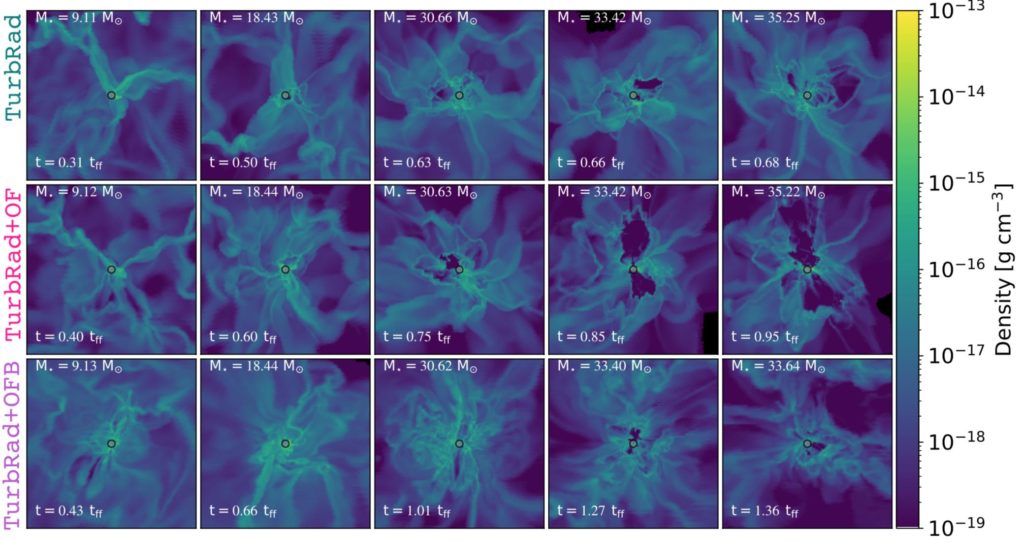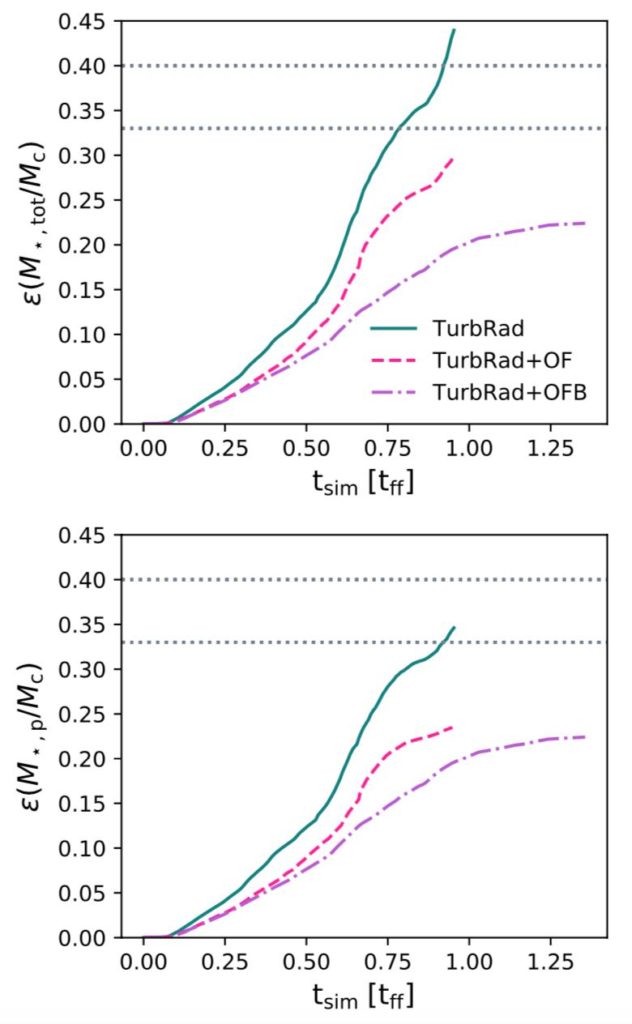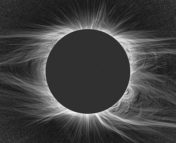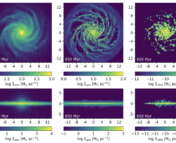Title: The Role of Outflows, Radiation Pressure, and Magnetic Fields in Massive Star Formation
Authors: Anna Rosen and Mark Krumholz
First Author’s Institution: Center for Astrophysics, Harvard & Smithsonian, Cambridge, MA
Status: Accepted to ApJ, open access on arXiv
Stellar physics is a broad field that touches on a range of phenomena from magnetic fields to radiative processes and thermonuclear fusion to plasmas. Stars form through the gravitational collapse of cold, dense, dusty proto-stellar cores, themselves embedded in thick molecular clouds or filaments. Massive stars, defined as those with a mass greater than 8 solar masses, are of key interest in star formation. Although they are extremely rare, comprising less than 1% of the total stellar population, they make their presence known by dominating the surrounding interstellar medium (ISM) with their powerful stellar winds as well as shocks from their eventual supernovae. Their formation is known to be impeded by several feedback mechanisms, including outflows, radiation pressure and magnetic fields. Today’s paper uses a series of radiative magnetohydrodynamic (RMHD) simulations to understand the overall impact that these combined mechanisms have on star formation.
Pushing the Boundaries
The fact that massive stars are so rare is reflective of a more general problem with star formation: its inefficiency. Estimates of star formation efficiencies (SFEs) are as low as 33%. As massive stars begin to form, they launch powerful molecular outflows from their poles. These jets can interact with the surrounding molecular cloud and eject large quantities of material. This, in combination with other feedback mechanisms, limits the star’s ability to accrete material, ultimately limiting its final mass. Knowing the upper limit of just how massive a star can be is incredibly valuable, for it allows us to set the upper boundary of the initial mass function (IMF). An IMF is a model of the initial distribution of stellar masses for a given population of stars. It is impossible to simulate the evolution of a stellar population without one. This is where massive stars are important, for they are the dominant source of radiative feedback and energy injection into the ISM through supernovae. So, to help determine these upper mass limits, we must simulate the processes that inhibit star formation in as much detail as possible.
Massively Magnetic Outflows Radiation Pressure (Games)
What does an MMORPG like EVE Online have in common with a radiative magnetohydrodynamic simulation? An insane amount of calculations. As the name implies, such a simulation models radiative transfer in addition to magneto-fluid dynamics. The simulation models stellar radiation fields and collimated outflows (the flow is parallel everywhere) for every star, and also factors in the indirect radiative feedback from dust, magnetic fields and supersonic turbulence. The authors ran 3 main simulations: TurbRad (radiative feedback only), TurbRad+OF (adds collimated outflows) and TurbRad+OFB (adds magnetic fields).

In Figure 1, after the stellar mass of the proto-stellar core exceeds 30 solar masses we see several pressure-dominated bubbles expanding away from the star (this is most noticeable in the middle row TurbRad+OF simulation). This process is known as the “flashlight effect”, where thick material is beamed away from the poles, causing low-density bubbles to expand outwards.
Go With The Flow
Over time, strong entrained outflows begin to break through the proto-stellar core and eject large quantities of material, as can be seen in Figure 2.

The outflows in Figure 2 become steadier and more directed over time. Although the proto-stellar core is initially highly turbulent, as it accretes material its rotational axis stabilises over time. One of the key results of these simulations is that the momentum feedback from these outflows is the dominant feedback mechanism (compared to radiation pressure) and helps to eject significant fractions of material, reducing the star formation efficiency. Outflows also help to act as conduit through which radiation can escape, weakening the feedback effects from radiation pressure.
Don’t Forget the B Field

Magnetic fields are known to affect star formation. Indeed, Figure 3 shows that the SFE is further reduced by the presence of magnetic fields (compare the purple dashed line to the pink dashed line). Overall, the simulations that contained outflows resulted in smaller SFEs. So in order to reconcile observations that place overall star formation efficiency at around 33%, this work shows that it is necessary to account for the effects of outflows.
In such an involved phenomena like star formation, there are many nuances. Magnetic fields slow the growth rate of stars by helping to prevent the core from fragmenting, however there are several non-ideal effects (such as the Hall effect) that could theoretically impact the star formation process. These non-ideal effects were not considered, although it is unknown whether such effects have any noticeable impact on SFEs.
A Joint Effort
This comprehensive series of simulations, one of the first to account for so many factors, demonstrates the role of outflows, magnetic fields and radiation pressure in limiting the formation of massive stars and reducing the overall SFE. This study shows that feedback from outflows dominates the feedback from radiation pressure, and that magnetic fields further inhibit star formation. Importantly, both outflows and magnetic fields are needed to reproduce the low efficiencies obtained from observations.




